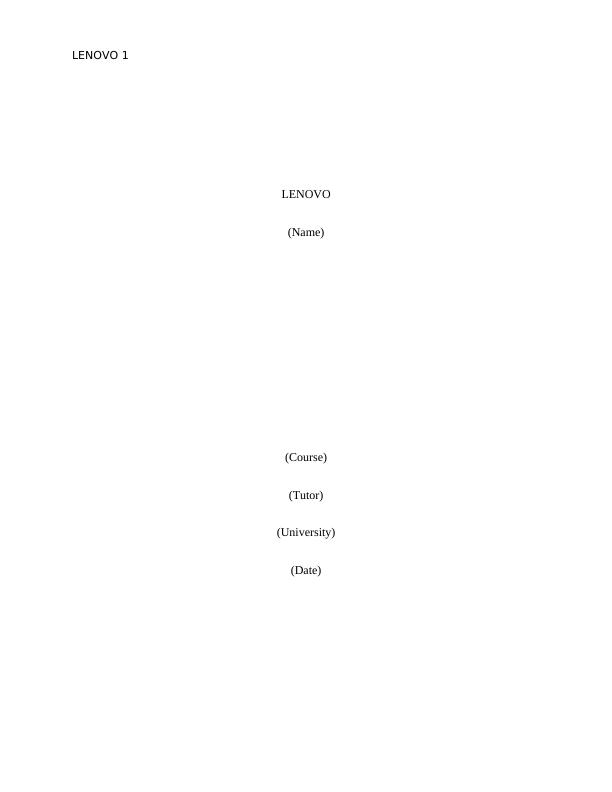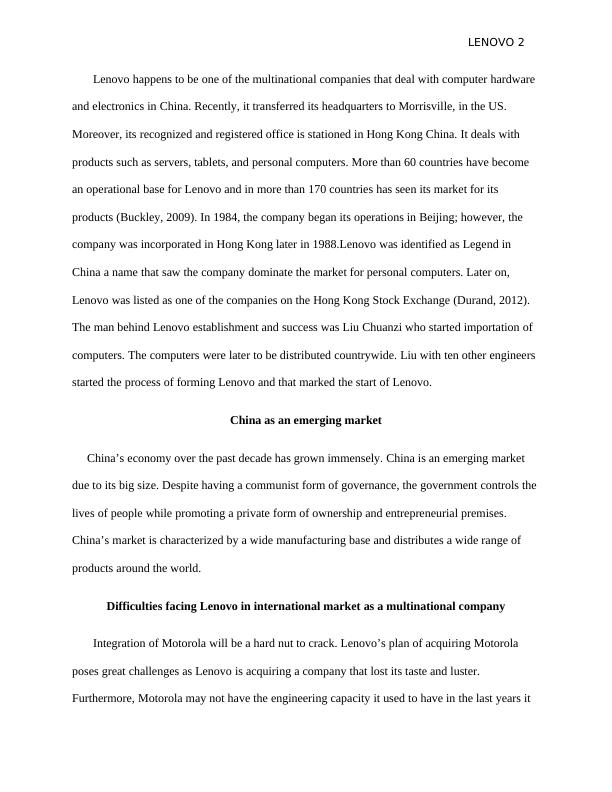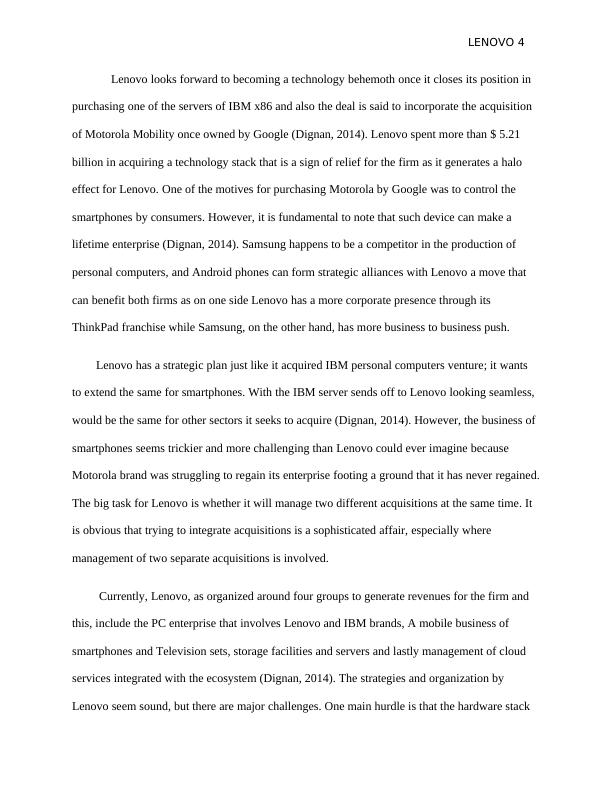BUS 346 - Lenovo Report - Global Business Environment
Added on 2020-03-02
15 Pages3814 Words38 Views
LENOVO 1
LENOVO
(Name)
(Course)
(Tutor)
(University)
(Date)
LENOVO
(Name)
(Course)
(Tutor)
(University)
(Date)

LENOVO 2
Lenovo happens to be one of the multinational companies that deal with computer hardware
and electronics in China. Recently, it transferred its headquarters to Morrisville, in the US.
Moreover, its recognized and registered office is stationed in Hong Kong China. It deals with
products such as servers, tablets, and personal computers. More than 60 countries have become
an operational base for Lenovo and in more than 170 countries has seen its market for its
products (Buckley, 2009). In 1984, the company began its operations in Beijing; however, the
company was incorporated in Hong Kong later in 1988.Lenovo was identified as Legend in
China a name that saw the company dominate the market for personal computers. Later on,
Lenovo was listed as one of the companies on the Hong Kong Stock Exchange (Durand, 2012).
The man behind Lenovo establishment and success was Liu Chuanzi who started importation of
computers. The computers were later to be distributed countrywide. Liu with ten other engineers
started the process of forming Lenovo and that marked the start of Lenovo.
China as an emerging market
China’s economy over the past decade has grown immensely. China is an emerging market
due to its big size. Despite having a communist form of governance, the government controls the
lives of people while promoting a private form of ownership and entrepreneurial premises.
China’s market is characterized by a wide manufacturing base and distributes a wide range of
products around the world.
Difficulties facing Lenovo in international market as a multinational company
Integration of Motorola will be a hard nut to crack. Lenovo’s plan of acquiring Motorola
poses great challenges as Lenovo is acquiring a company that lost its taste and luster.
Furthermore, Motorola may not have the engineering capacity it used to have in the last years it
Lenovo happens to be one of the multinational companies that deal with computer hardware
and electronics in China. Recently, it transferred its headquarters to Morrisville, in the US.
Moreover, its recognized and registered office is stationed in Hong Kong China. It deals with
products such as servers, tablets, and personal computers. More than 60 countries have become
an operational base for Lenovo and in more than 170 countries has seen its market for its
products (Buckley, 2009). In 1984, the company began its operations in Beijing; however, the
company was incorporated in Hong Kong later in 1988.Lenovo was identified as Legend in
China a name that saw the company dominate the market for personal computers. Later on,
Lenovo was listed as one of the companies on the Hong Kong Stock Exchange (Durand, 2012).
The man behind Lenovo establishment and success was Liu Chuanzi who started importation of
computers. The computers were later to be distributed countrywide. Liu with ten other engineers
started the process of forming Lenovo and that marked the start of Lenovo.
China as an emerging market
China’s economy over the past decade has grown immensely. China is an emerging market
due to its big size. Despite having a communist form of governance, the government controls the
lives of people while promoting a private form of ownership and entrepreneurial premises.
China’s market is characterized by a wide manufacturing base and distributes a wide range of
products around the world.
Difficulties facing Lenovo in international market as a multinational company
Integration of Motorola will be a hard nut to crack. Lenovo’s plan of acquiring Motorola
poses great challenges as Lenovo is acquiring a company that lost its taste and luster.
Furthermore, Motorola may not have the engineering capacity it used to have in the last years it

LENOVO 3
had become part Google. Also, the brand name may not fetch a market in countries such as the
US as it has a limited share of the market.
Lenovo’s ambitions of dominating smartphone business may be a dream far from reality
following the fact that Lenovo has a limited supply chain. A big proportion of the supply chain
has been taken by companies such as Apple and Samsung.
Lenovo may also be incapacitated regarding finance. Engaging Motorola will see the company
drain its resources in developing the acquired company. As a result, Lenovo may end up
spending money in other sectors that were unplanned.
Difficulties faced by Lenovo as MNC
Many acquisitions more so from developing nations failed in many cases, and the case for
Lenovo was exceptionally appealing and inspired other firms considering an acquisition in
developed nations. Lenovo as one of its strategy it retained the staff of IBM employees from the
PC sector. Such a move ensured that the skills acquired from ex-employees of Lenovo were
incorporated into Lenovo human resource management (Weber and Yedidia Tarba 2012).
Lenovo understood one thing for sure that they lacked the technicalities to manage a global
business. For the other firms that tried acquisition, they failed due to lack of a pool of
management to operate on a global platform. The staff from Lenovo had the experience of
operating overseas markets, and that is what Lenovo lacked and needed such people to be
successful in its acquisition. The tacit knowledge and expertise were critical if Lenovo was to
achieve its desired goals and objectives of dominating the world market for PCs.
How Lenovo became a MNC and the entry strategy used in global markets
had become part Google. Also, the brand name may not fetch a market in countries such as the
US as it has a limited share of the market.
Lenovo’s ambitions of dominating smartphone business may be a dream far from reality
following the fact that Lenovo has a limited supply chain. A big proportion of the supply chain
has been taken by companies such as Apple and Samsung.
Lenovo may also be incapacitated regarding finance. Engaging Motorola will see the company
drain its resources in developing the acquired company. As a result, Lenovo may end up
spending money in other sectors that were unplanned.
Difficulties faced by Lenovo as MNC
Many acquisitions more so from developing nations failed in many cases, and the case for
Lenovo was exceptionally appealing and inspired other firms considering an acquisition in
developed nations. Lenovo as one of its strategy it retained the staff of IBM employees from the
PC sector. Such a move ensured that the skills acquired from ex-employees of Lenovo were
incorporated into Lenovo human resource management (Weber and Yedidia Tarba 2012).
Lenovo understood one thing for sure that they lacked the technicalities to manage a global
business. For the other firms that tried acquisition, they failed due to lack of a pool of
management to operate on a global platform. The staff from Lenovo had the experience of
operating overseas markets, and that is what Lenovo lacked and needed such people to be
successful in its acquisition. The tacit knowledge and expertise were critical if Lenovo was to
achieve its desired goals and objectives of dominating the world market for PCs.
How Lenovo became a MNC and the entry strategy used in global markets

LENOVO 4
Lenovo looks forward to becoming a technology behemoth once it closes its position in
purchasing one of the servers of IBM x86 and also the deal is said to incorporate the acquisition
of Motorola Mobility once owned by Google (Dignan, 2014). Lenovo spent more than $ 5.21
billion in acquiring a technology stack that is a sign of relief for the firm as it generates a halo
effect for Lenovo. One of the motives for purchasing Motorola by Google was to control the
smartphones by consumers. However, it is fundamental to note that such device can make a
lifetime enterprise (Dignan, 2014). Samsung happens to be a competitor in the production of
personal computers, and Android phones can form strategic alliances with Lenovo a move that
can benefit both firms as on one side Lenovo has a more corporate presence through its
ThinkPad franchise while Samsung, on the other hand, has more business to business push.
Lenovo has a strategic plan just like it acquired IBM personal computers venture; it wants
to extend the same for smartphones. With the IBM server sends off to Lenovo looking seamless,
would be the same for other sectors it seeks to acquire (Dignan, 2014). However, the business of
smartphones seems trickier and more challenging than Lenovo could ever imagine because
Motorola brand was struggling to regain its enterprise footing a ground that it has never regained.
The big task for Lenovo is whether it will manage two different acquisitions at the same time. It
is obvious that trying to integrate acquisitions is a sophisticated affair, especially where
management of two separate acquisitions is involved.
Currently, Lenovo, as organized around four groups to generate revenues for the firm and
this, include the PC enterprise that involves Lenovo and IBM brands, A mobile business of
smartphones and Television sets, storage facilities and servers and lastly management of cloud
services integrated with the ecosystem (Dignan, 2014). The strategies and organization by
Lenovo seem sound, but there are major challenges. One main hurdle is that the hardware stack
Lenovo looks forward to becoming a technology behemoth once it closes its position in
purchasing one of the servers of IBM x86 and also the deal is said to incorporate the acquisition
of Motorola Mobility once owned by Google (Dignan, 2014). Lenovo spent more than $ 5.21
billion in acquiring a technology stack that is a sign of relief for the firm as it generates a halo
effect for Lenovo. One of the motives for purchasing Motorola by Google was to control the
smartphones by consumers. However, it is fundamental to note that such device can make a
lifetime enterprise (Dignan, 2014). Samsung happens to be a competitor in the production of
personal computers, and Android phones can form strategic alliances with Lenovo a move that
can benefit both firms as on one side Lenovo has a more corporate presence through its
ThinkPad franchise while Samsung, on the other hand, has more business to business push.
Lenovo has a strategic plan just like it acquired IBM personal computers venture; it wants
to extend the same for smartphones. With the IBM server sends off to Lenovo looking seamless,
would be the same for other sectors it seeks to acquire (Dignan, 2014). However, the business of
smartphones seems trickier and more challenging than Lenovo could ever imagine because
Motorola brand was struggling to regain its enterprise footing a ground that it has never regained.
The big task for Lenovo is whether it will manage two different acquisitions at the same time. It
is obvious that trying to integrate acquisitions is a sophisticated affair, especially where
management of two separate acquisitions is involved.
Currently, Lenovo, as organized around four groups to generate revenues for the firm and
this, include the PC enterprise that involves Lenovo and IBM brands, A mobile business of
smartphones and Television sets, storage facilities and servers and lastly management of cloud
services integrated with the ecosystem (Dignan, 2014). The strategies and organization by
Lenovo seem sound, but there are major challenges. One main hurdle is that the hardware stack

End of preview
Want to access all the pages? Upload your documents or become a member.
Related Documents
Company Analysis | Lenovo Grouplg...
|8
|2021
|36
Human Capitallg...
|22
|6176
|490
Introduction of Lenovo: Organisational backgroundlg...
|20
|2077
|48
Analyzing Lenovo's Business Expansion Strategy in the Global Smartphone Industrylg...
|15
|2979
|250
Report-HSBC | Commercial & Internal Analysislg...
|15
|5130
|48
Business Intelligence Using Big Data Assignmentlg...
|18
|4616
|69
